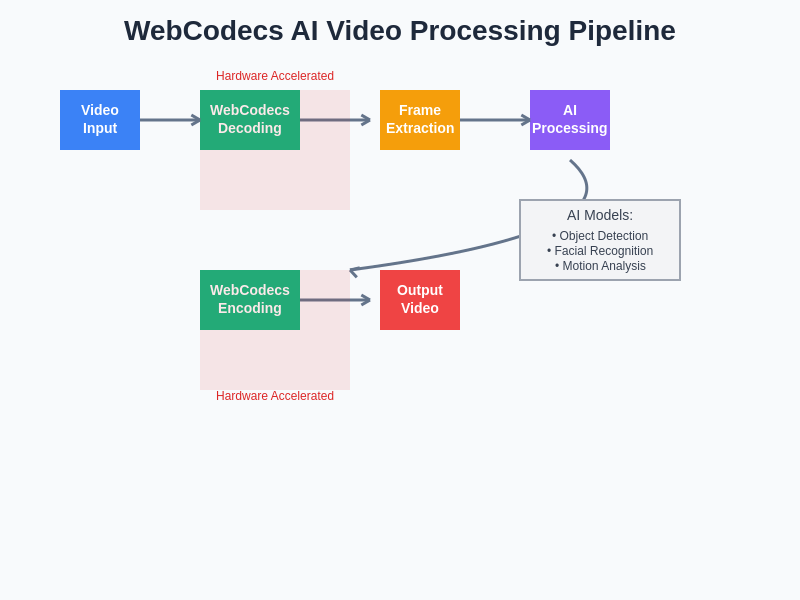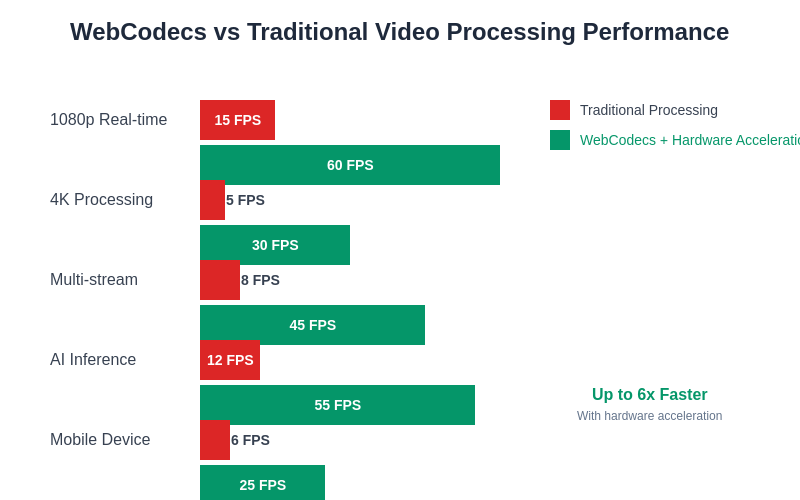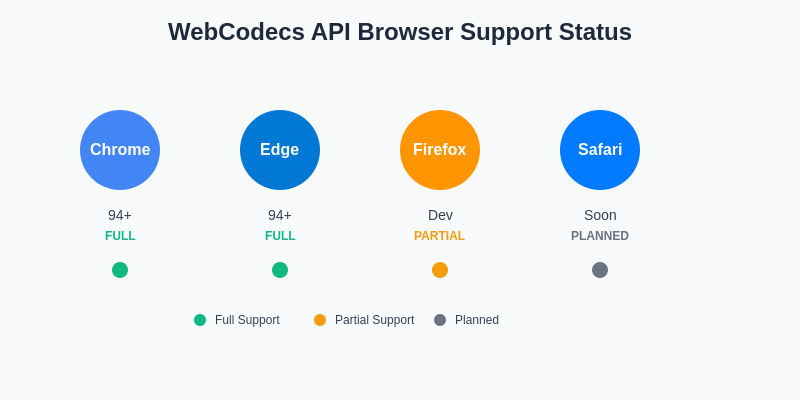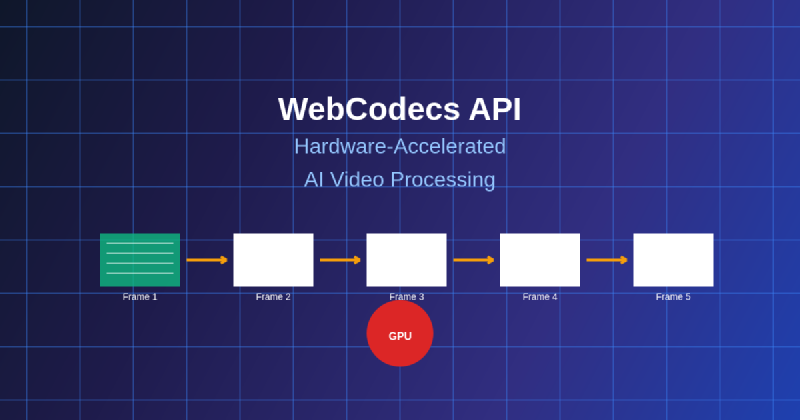The convergence of web technologies and artificial intelligence has reached a pivotal moment with the introduction of the WebCodecs API, a revolutionary web standard that brings hardware-accelerated video processing capabilities directly to web browsers. This groundbreaking technology represents a fundamental shift in how developers approach video-based AI applications, enabling sophisticated machine learning workflows that were previously confined to native applications or server-side processing environments.
Discover the latest trends in AI video processing to understand how cutting-edge technologies are reshaping multimedia applications and opening new possibilities for real-time AI inference. The WebCodecs API stands at the intersection of web development and artificial intelligence, providing unprecedented access to low-level video processing capabilities that unlock new paradigms for interactive, real-time AI-powered applications.
Understanding the WebCodecs API Foundation
The WebCodecs API represents a paradigm shift in web-based video processing by providing direct access to video encoding and decoding capabilities that leverage underlying hardware acceleration. Unlike traditional video processing approaches that rely on high-level abstractions or server-side processing, WebCodecs enables developers to work directly with video frames, audio samples, and codec-specific parameters at a granular level that was previously inaccessible in web environments.
This low-level access to video processing primitives creates unprecedented opportunities for AI applications that require real-time analysis of video content. The API’s design philosophy centers around providing maximum flexibility and performance while maintaining the security and portability characteristics that define modern web standards. By exposing hardware-accelerated encoding and decoding capabilities, WebCodecs eliminates many of the performance bottlenecks that have historically limited the sophistication of web-based video AI applications.
The architectural foundation of WebCodecs is built upon well-established video processing standards while providing web-native interfaces that integrate seamlessly with existing web technologies. This approach ensures that AI developers can leverage familiar web development patterns while accessing the high-performance video processing capabilities necessary for demanding machine learning workflows.

The processing pipeline demonstrates how WebCodecs facilitates seamless integration between video input, hardware-accelerated decoding and encoding, frame extraction, and AI processing components, creating an efficient workflow that maximizes performance while maintaining the flexibility required for sophisticated machine learning applications.
Hardware Acceleration Capabilities and Performance Benefits
The true power of the WebCodecs API lies in its ability to harness dedicated video processing hardware present in modern computing devices. Graphics processing units, specialized video encoding chips, and other hardware accelerators can be directly utilized through the API, providing performance improvements that are often orders of magnitude better than software-based alternatives.
Experience advanced AI capabilities with Claude to explore how hardware acceleration transforms the possibilities for real-time video analysis and machine learning inference. The performance benefits extend beyond simple speed improvements, enabling entirely new categories of applications that require real-time processing of high-resolution video streams while maintaining acceptable power consumption and thermal characteristics.
Hardware acceleration through WebCodecs is particularly transformative for AI applications that process multiple video streams simultaneously, perform real-time object detection and tracking, or require low-latency video analysis for interactive applications. The API’s ability to offload computationally intensive video processing tasks to specialized hardware frees up CPU resources for AI inference and other application logic, creating more balanced and efficient system utilization.
The performance characteristics achieved through hardware acceleration also enable AI applications to scale more effectively across different device categories, from high-end workstations to mobile devices with limited processing capabilities. This democratization of high-performance video processing capabilities represents a significant advancement in making sophisticated AI applications accessible across diverse hardware platforms.

The performance advantages of WebCodecs with hardware acceleration become particularly evident when processing high-resolution video content and handling multiple concurrent streams, with improvements of up to 6x compared to traditional software-based video processing approaches across various scenarios and device configurations.
Real-Time AI Video Analysis Applications
The combination of WebCodecs API and AI technologies opens unprecedented possibilities for real-time video analysis applications that operate entirely within web browsers. Computer vision algorithms can now process video streams with minimal latency, enabling applications such as real-time object detection, facial recognition, motion analysis, and content classification without requiring server-side processing or native application development.
Real-time AI video analysis through WebCodecs enables applications to respond immediately to visual events, creating interactive experiences that were previously impossible in web environments. Security monitoring systems can detect anomalies in real-time, educational applications can provide immediate feedback on student activities, and entertainment platforms can create responsive, AI-driven interactive content that adapts to user behavior and environmental conditions.
The low-latency characteristics of hardware-accelerated video processing also enable AI applications to maintain synchronization between video streams and real-time inference results, creating seamless user experiences where AI analysis appears instantaneous. This capability is particularly valuable for applications that require immediate responses to visual stimuli, such as augmented reality overlays, real-time content moderation, or interactive gaming experiences.
Integration with Machine Learning Frameworks
The WebCodecs API’s design facilitates seamless integration with popular machine learning frameworks and libraries, creating a powerful ecosystem for AI-powered video applications. TensorFlow.js, ONNX.js, and other web-based ML frameworks can efficiently consume video frames processed through WebCodecs, enabling sophisticated neural network inference on video content with optimal performance characteristics.
This integration capability extends to both pre-trained models and custom neural networks designed specifically for video analysis tasks. The API’s frame-level access enables AI applications to implement sophisticated preprocessing pipelines, temporal analysis across multiple frames, and post-processing workflows that enhance the accuracy and reliability of machine learning inference results.
The flexibility of WebCodecs also supports advanced AI architectures such as recurrent neural networks for temporal video analysis, convolutional neural networks for spatial feature extraction, and transformer-based models for complex video understanding tasks. This versatility ensures that developers can implement state-of-the-art AI algorithms while maintaining the performance benefits of hardware-accelerated video processing.
Advanced Video Processing Pipelines
WebCodecs enables the construction of sophisticated video processing pipelines that combine multiple AI techniques and processing stages into cohesive workflows. These pipelines can incorporate video stabilization, noise reduction, frame interpolation, and other enhancement techniques alongside AI inference, creating comprehensive video analysis systems that deliver superior results compared to simpler processing approaches.
Explore comprehensive AI research capabilities with Perplexity to discover advanced techniques for optimizing video processing pipelines and integrating multiple AI models for enhanced performance. The ability to construct custom processing pipelines also enables developers to optimize workflows for specific use cases, balancing computational requirements, accuracy, and real-time performance constraints.
Advanced pipeline architectures can implement parallel processing of multiple video streams, hierarchical analysis with different AI models operating at various resolutions, and adaptive processing that adjusts computational complexity based on content characteristics and available hardware resources. These sophisticated approaches enable AI applications to achieve optimal performance while maintaining flexibility and scalability across different deployment scenarios.
Cross-Platform Compatibility and Browser Support
The WebCodecs API’s standardized approach ensures consistent behavior across different browsers and operating systems while leveraging platform-specific hardware acceleration capabilities. This cross-platform compatibility eliminates many of the challenges associated with deploying AI video applications across diverse environments, enabling developers to create solutions that work seamlessly regardless of the underlying hardware and software configurations.
Browser vendors have implemented WebCodecs with careful attention to security, performance, and compatibility considerations, ensuring that AI applications can rely on consistent behavior while accessing powerful video processing capabilities. The API’s design also includes graceful degradation mechanisms that enable applications to function effectively even when hardware acceleration is not available, ensuring broad compatibility across different device categories.

The current browser support landscape shows strong adoption in Chromium-based browsers with ongoing development efforts across other major browser platforms, indicating a promising future for widespread WebCodecs API availability and consistent cross-platform video processing capabilities.
The standardization of WebCodecs across browser platforms also facilitates the development of portable AI video applications that can be deployed as web applications without requiring platform-specific adaptations or native application development. This portability significantly reduces development complexity while expanding the potential reach of AI-powered video applications.
Security and Privacy Considerations
The WebCodecs API implementation includes comprehensive security measures designed to protect user privacy while enabling powerful video processing capabilities. These security features ensure that AI applications can access video content and processing capabilities without compromising user data or system security, maintaining the trust and safety characteristics that are essential for web-based applications.
Privacy protection mechanisms within WebCodecs ensure that video processing operations remain isolated from other web content and cannot be exploited to access unauthorized data or compromise system security. These protections are particularly important for AI applications that process sensitive video content, such as security monitoring systems or personal video analysis tools.
The API’s security model also includes provisions for secure communication between AI processing components and video data sources, ensuring that sensitive information remains protected throughout the processing pipeline. These security considerations enable the development of AI applications that can be trusted with sensitive video content while maintaining the accessibility and convenience characteristics of web-based solutions.
Performance Optimization Strategies
Optimizing AI video applications that utilize WebCodecs requires understanding both the API’s capabilities and the characteristics of underlying hardware acceleration systems. Effective optimization strategies involve careful management of video processing resources, intelligent buffering and caching mechanisms, and adaptive algorithms that adjust processing complexity based on available computational resources and performance requirements.
Memory management represents a critical aspect of performance optimization, as video processing applications can consume significant amounts of system memory when handling high-resolution video streams. WebCodecs provides mechanisms for efficient memory utilization that minimize garbage collection overhead and ensure consistent performance characteristics even during extended processing sessions.
Optimization strategies also include intelligent selection of video processing parameters, such as codec selection, resolution scaling, and frame rate adaptation, based on the specific requirements of AI inference algorithms and available hardware capabilities. These adaptive approaches enable AI applications to achieve optimal performance while maintaining acceptable quality levels for machine learning analysis.
Future Developments and Industry Impact
The WebCodecs API represents the foundation for a new generation of web-based AI applications that will fundamentally transform how video content is processed, analyzed, and understood. As the API continues to evolve and browser support expands, we can expect to see increasingly sophisticated AI applications that leverage hardware acceleration to deliver capabilities previously reserved for specialized software and high-end hardware configurations.
Future developments in WebCodecs are likely to include enhanced support for emerging video formats, improved integration with AI-specific hardware accelerators, and expanded capabilities for real-time video manipulation and generation. These advancements will enable even more powerful AI applications while maintaining the accessibility and cross-platform compatibility that characterize web-based solutions.
The industry impact of WebCodecs extends beyond individual applications to encompass entire categories of AI-powered services and platforms. The democratization of hardware-accelerated video processing capabilities will enable smaller development teams and organizations to create sophisticated AI applications that compete with solutions developed by larger technology companies, fostering innovation and expanding the diversity of available AI-powered video services.
Implementation Best Practices and Development Guidelines
Successful implementation of AI video applications using WebCodecs requires adherence to established best practices that ensure optimal performance, reliability, and user experience. These guidelines encompass everything from initial application architecture decisions to detailed optimization techniques that maximize the benefits of hardware acceleration while maintaining code maintainability and scalability.
Development best practices include careful consideration of error handling mechanisms, as video processing operations can fail due to hardware limitations, codec incompatibilities, or resource constraints. Robust error handling ensures that AI applications can gracefully handle these situations while providing meaningful feedback to users and maintaining system stability.
Testing strategies for WebCodecs-based AI applications must account for the wide variety of hardware configurations and browser implementations that users may encounter. Comprehensive testing across different devices, operating systems, and browser versions ensures that applications deliver consistent performance and functionality regardless of the deployment environment.
The integration of performance monitoring and analytics capabilities enables developers to understand how their AI applications perform in real-world usage scenarios and identify opportunities for optimization and enhancement. These insights are particularly valuable for applications that serve diverse user bases with varying hardware capabilities and usage patterns.
Conclusion and Future Prospects
The WebCodecs API represents a transformative technology that bridges the gap between web development and high-performance video processing, enabling a new generation of AI applications that operate entirely within web browsers while leveraging hardware acceleration capabilities. This convergence of web standards and AI technologies opens unprecedented opportunities for developers to create sophisticated, real-time video analysis applications that are accessible across diverse platforms and devices.
The continued evolution of WebCodecs, combined with advances in AI algorithms and hardware acceleration technologies, promises to unlock even more powerful capabilities for web-based video AI applications. As these technologies mature and become more widely adopted, we can expect to see fundamental changes in how video content is processed, analyzed, and understood across numerous industries and application domains.
The democratization of hardware-accelerated video processing through web standards like WebCodecs will likely accelerate innovation in AI applications while reducing barriers to entry for developers and organizations seeking to leverage video-based machine learning capabilities. This accessibility will foster the development of more diverse and innovative AI solutions that address a broader range of use cases and user needs.
Disclaimer
This article is for informational purposes only and does not constitute professional advice. The views expressed are based on current understanding of WebCodecs API capabilities and AI video processing technologies. Readers should conduct their own research and testing when implementing video processing applications. Performance characteristics and browser support may vary depending on specific hardware configurations, software versions, and implementation details. The effectiveness of AI video processing applications may depend on various factors including hardware capabilities, network conditions, and specific use case requirements.
